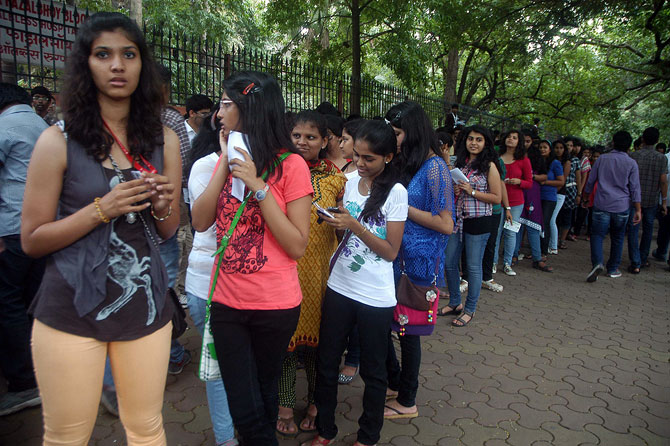Photographs: Sahil Salvi Morningstar.in
With over 50 per cent of its current population under 25 years of age, India's great demographic "dividend" needs to change a few habits—immediately -- or it may be too late.
Without action soon, India's 'demographic dividend' could become a retirement deficit as the country's population ages over the next 40 years.
India is on its way to becoming the most populous nation in the world by 2025, surpassing China.
By 2050, the number of Indians above the age of 65 will cross 200 million from about 80 million currently, while the number of Indians above 80 years of age will be at 43 million, second only to China.
According to a survey by HSBC titled, "The Future of Retirement--It's Time to Prepare," by 2050 India's elderly will equal the number of its children for the first time ever. Further, a United Nations study points out that, in line with the global trend of increased life expectancies and declining fertility rates, old-age dependency ratios will increase, particularly in developing countries like India.
Quite clearly, greater resources will need to be set aside for the elderly. There is a "significant requirement for retirement planning, both at the individual level and for the Indian population as a whole," says Canara HSBC OBC Life Insurance Company's appointed actuary Chirag Rathod. "This requires increased awareness as a society about the need for proper retirement planning and the real threat of outliving your savings."
Given the sheer scale of this impending demographic shift, India's plan -- or the lack of one -- to take care of its elderly, deserves a closer look.
For young Indians, time for retirement planning is now!
Photographs: Uttam Ghosh/Rediff.com Morningstar.in
Current retirement accounts
India doesn't currently have a broad social security plan like the United States, but policymakers have created some retirement-focused savings vehicles.
Established in the 1950s, the Employees Provident Fund (EPF) is most similar to the US Social Security program, but its coverage is much more limited. Participation is compulsory only for employers with 20 or more workers and for workers who have a basic salary of more than Rs 6,291 per month.
Both employee and employer contribute a certain amount (either 12 per cent of basic salary or Rs 780) to the individual's EPF account, on which participants get a fixed rate of interest. The EPF falls under the purview of the Employees Provident Fund Organisation (EPFO), which has traditionally given the responsibility of managing these funds to state-owned or government-backed lenders.
The EPF is not without its problems. The first is reach: It covers only the organised, formally employed segment of the working population, while the vast majority of Indians -- including entrepreneurs, self-employed businessmen, the agricultural labour force, and others -- work in the so-called "unorganised" sector. In addition, while the government offered a high rate of interest in the early years of the plan, yields have since come down. And although the EPF's automatic contributions instill investing discipline on workers, participants can withdraw their savings after leaving their current job in lieu of transferring their account to their next employer, in the process dealing a big blow to their retirement savings potential.
In a move away from the defined benefit EPF, the Indian government established the National Pension Scheme, or NPS, in 2009 in an attempt to create a defined contribution plan along the lines of the 401(k) in the United States. However, unlike the 401(k), which is offered through employers in the US, any Indian citizen between 18 and 60 years of age can invest in the NPS, which is administered to individuals through point-of-presence service provider outlets, which act as collection points.
NPS participants can exercise some control over how their contributions are invested. The government has defined three asset classes:
E: High return/high risk, which invests in predominantly equity market instruments
C: Medium return/medium risk, which invests in predominantly fixed-income instruments; and
G: Low return/low risk, which invests in purely fixed-income instruments.
Participants can choose to invest their entire amount in the C or G asset classes, but only up to a maximum of 50 per cent in equity (class E).
In case participants are unwilling or unable to exercise a choice regarding their investment strategy, funds are invested in accordance with an auto-choice option across the asset classes in percentage allocations prescribed by the Pension Fund Regulatory Development Authority depending on the participant's age.
Although many feel that the NPS is a broad step in the right direction, a few wrinkles still need ironing. First, the Indian government has launched probably the cheapest financial product in the world, setting a charge of just 0.0009 per cent in management fees. Although low fees are great for investors, it's no wonder the government-appointed funds for running the NPS aren't especially motivated to promote wider adoption of the scheme.
Second, the mandatory requirement of purchasing an annuity upon reaching the retirement age goes against the scheme for the simple reason there aren't any annuity providers to speak of due to an under-developed annuities market in India, which further complicates the matter.
On a hopeful note, the Pension Fund Regulatory and Development Authority Bill, which is seeking to set up an authority to regulate retirement funds, is also aiming to allow foreign investments in the pension sector. Once this happens, foreign companies would also be able to manage pension funds, providing investors with more options for growing their savings.
However, the policy reforms have been deferred time and again due to a lack of political consensus, publicising the central government's vulnerability and reluctance to hasten decision-making for fear of angering coalition partners.
For young Indians, time for retirement planning is now!
Photographs: Dominic Xavier/Rediff.com Morningstar.in
Planning hurdles
In such a scenario, the absence of a broad social security system is made worse by the fact that retirement planning is not a top priority for most Indians. According to HSBC's survey, while India has a higher savings ratio compared with other countries, this is skewed toward saving for children, which accounts for 35 per cent of savings. This money is typically set aside for marriage (especially in the case of a female child) and education. Meanwhile retirement funds account for only 12 per cent of one's total savings.
Moreover, says HSBC, traditional social structures such as joint families and extended community support post-retirement are becoming less relevant as a society in flux embraces rapid urbanisation, leading to an increasingly significant need for individual retirement planning.
Mumbai-based financial planner Harsh Vardhan Dawar of Wealth Cafe Financial Advisors agrees, noting that "Our parents' generation tended to depend on their children. But people don't have that mindset anymore."
Dawar says various studies estimate that over 35 per cent of the elderly in urban India alone depend on their children for support at present, but that's set to decrease dramatically with the current generation of youth. "This trend is expected to grow with a larger percentage of the current working generation preferring to build their own retirement corpus and not leave things on their children," he says.
He estimates that only about 3 per cent-4 per cent of the population depend on government-funded programmes/welfare schemes and corporate pensions. For most, the government-funded programmes are not very popular and do not provide adequate support in any case. Rural development minister Jairam Ramesh earlier this year famously described one such welfare programme -- the Indira Gandhi National Old Age Pension Scheme, under which Rs 200 a month is given to 30 million people over the age of 60 who are below the poverty line -- as an "insult to the dignity of the individual."
Another 17 per cent-18 per cent of the population depend on their own investments, Dawar estimates. Even here, the instruments used are typically undifferentiated savings products such as fixed deposits or small savings schemes run by the government, says HSBC's Rathod. "While there is awareness of life insurance as a category and to a smaller extent pension plans from life insurers, their usage has largely been driven by specific tax exemptions earlier available on these investments rather than as an outcome of detailed financial planning and retirement accumulation," he says.
Traditionally, there has also been a significant reliance on non-financial assets such as residential property or physical gold for creating the retirement savings pool. The social importance attached to bequeathing a residential property to one's children is also one of the reasons why reverse mortgage schemes haven't found many takers, says Dawar. Such products are not well-developed, either.
With a vast majority of the population still outside any sort of social security net, it's up to financial planners like Dawar and his ilk to continuously reach out to potential customers among the "middle and upper middle classes who can afford to set plans for their retirement independently. The HNI category investors have enough funds and are less worried about the retirement phase," Dawar explains.
Newer trends like retirement homes are catching on, but these projects are large scale and take time. So far, some retirement homes have come up in satellite nodes around major metropolitan areas. But these private-sector initiatives have been taken up by only a handful of real-estate developers and have yet to spread across the country.
While such changes are welcome and reflect the care a society affords to its more needy populations, the time for India is running out. According to a United Nations study, in less developed economies, older persons account for just 8 per cent of the population, but by 2050, they are expected to account for a fifth of the population, implying that by mid-century, the developing world is likely to reach the same stage in the process of aging that the developed world has already reached.
Also, the pace of population aging is faster in developing countries, giving them less time to adjust to the consequences of the demographic shift. Moreover, the UN study points out, population aging in developing countries is taking place at lower levels of socioeconomic development.
By 2050, India's favourable demographic profile could turn into an enormous burden on the country's resources as people age and need health care and other services befitting the elderly.





Comment
article